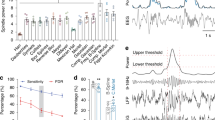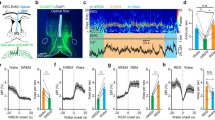Abstract
The thalamic reticular nucleus (TRN) is hypothesized to regulate neocortical rhythms and behavioral states. Using optogenetics and multi-electrode recording in behaving mice, we found that brief selective drive of TRN switched the thalamocortical firing mode from tonic to bursting and generated state-dependent neocortical spindles. These findings provide causal support for the involvement of the TRN in state regulation in vivo and introduce a new model for addressing the role of this structure in behavior.
This is a preview of subscription content, access via your institution
Access options
Subscribe to this journal
Receive 12 print issues and online access
$209.00 per year
only $17.42 per issue
Buy this article
- Purchase on Springer Link
- Instant access to full article PDF
Prices may be subject to local taxes which are calculated during checkout


Similar content being viewed by others
References
Sherman, S.M. Nat. Neurosci. 4, 344–346 (2001).
Steriade, M. Nat. Neurosci. 4, 671 (2001).
Lesica, N.A. et al. PLoS Biol. 4, e209 (2006).
McCormick, D.A. & Bal, T. Annu. Rev. Neurosci. 20, 185–215 (1997).
McAlonan, K., Cavanaugh, J. & Wurtz, R.H. Nature 456, 391–394 (2008).
Espinosa, F., Torres-Vega, M.A., Marks, G.A. & Joho, R.H. J. Neurosci. 28, 5570–5581 (2008).
Steriade, M., Domich, L., Oakson, G. & Deschenes, M. J. Neurophysiol. 57, 260–273 (1987).
Dang-Vu, T.T., McKinney, S.M., Buxton, O.M., Solet, J.M. & Ellenbogen, J.M. Curr. Biol. 20, R626–R627 (2010).
Sirota, A., Csicsvari, J., Buhl, D. & Buzsaki, G. Proc. Natl. Acad. Sci. USA 100, 2065–2069 (2003).
Sohal, V.S., Pangratz-Fuehrer, S., Rudolph, U. & Huguenard, J.R. J. Neurosci. 26, 4247–4255 (2006).
Bezdudnaya, T. et al. Neuron 49, 421–432 (2006).
Contreras, D., Destexhe, A., Sejnowski, T.J. & Steriade, M. J. Neurosci. 17, 1179–1196 (1997).
Nir, Y. et al. Neuron 70, 153–169 (2011).
Li, B., Funke, K., Worgotter, F. & Eysel, U.T. J. Physiol. (Lond.) 514, 857–874 (1999).
Ferrarelli, F. et al. Am. J. Psychiatry 167, 1339–1348 (2010).
Acknowledgements
This work was partially supported by a US National Institutes of Health award (R01 NS045130-05) to C.I.M.
Author information
Authors and Affiliations
Contributions
M.H., J.S. and C.I.M. designed the experiments and analyses. M.H. and J.S. conducted the experiments and analyses. J.T. and G.F. developed the transgenic model. J.S. and J.R. developed the optics-integrated chronic implants. M.H., J.S. and C.I.M. wrote the manuscript. C.I.M. supervised the project.
Corresponding authors
Ethics declarations
Competing interests
The authors declare no competing financial interests.
Supplementary information
Supplementary Text and Figures
Supplementary Figures 1–7 and Supplementary Materials and Methods (PDF 350 kb)
Rights and permissions
About this article
Cite this article
Halassa, M., Siegle, J., Ritt, J. et al. Selective optical drive of thalamic reticular nucleus generates thalamic bursts and cortical spindles. Nat Neurosci 14, 1118–1120 (2011). https://doi.org/10.1038/nn.2880
Received:
Accepted:
Published:
Issue Date:
DOI: https://doi.org/10.1038/nn.2880
This article is cited by
-
Pallidal GABA B receptors: involvement in cortex beta dynamics and thalamic reticular nucleus activity
The Journal of Physiological Sciences (2023)
-
The endocannabinoid N-arachidonoyl dopamine is critical for hyperalgesia induced by chronic sleep disruption
Nature Communications (2023)
-
Functional MRI reveals brain-wide actions of thalamically-initiated oscillatory activities on associative memory consolidation
Nature Communications (2023)
-
Cav3.1-driven bursting firing in ventromedial hypothalamic neurons exerts dual control of anxiety-like behavior and energy expenditure
Molecular Psychiatry (2022)
-
Alterations in TRN-anterodorsal thalamocortical circuits affect sleep architecture and homeostatic processes in oxidative stress vulnerable Gclm−/− mice
Molecular Psychiatry (2022)



